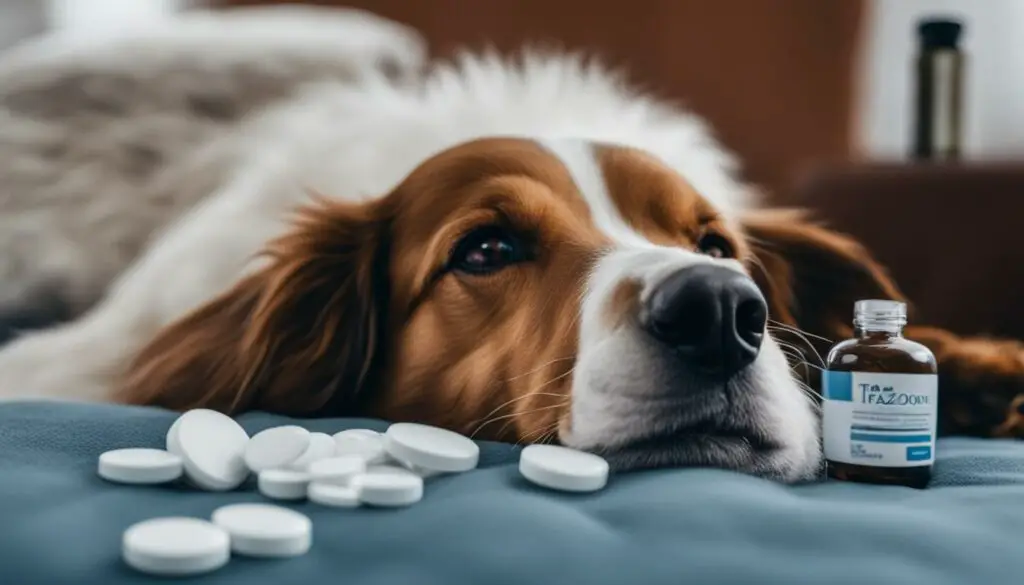Welcome to my article on trazodone for dogs! If you have a furry friend who suffers from anxiety or behavioral issues, you may have heard of this medication. Trazodone is an antidepressant commonly used off-label to help dogs manage their anxiety and improve their overall well-being.
In this article, I will delve into the details of trazodone for dogs, including what it is, how it works, and why it is prescribed. I’ll also discuss the potential side effects and offer tips on managing them. Additionally, I will explore alternative solutions for calming your pet and provide guidance on administering pills to your clever canine.
So, if you’re curious about trazodone for dogs and want to ensure your furry friend’s comfort and happiness, keep reading!
Key Takeaways:
- Trazodone is an antidepressant medication commonly used off-label to treat anxiety and behavioral issues in dogs.
- It can be prescribed to manage separation anxiety, noise phobias, and general anxiety in dogs.
- Trazodone should always be used under the guidance of a veterinarian and in conjunction with behavior modification training.
- Side effects may include drowsiness, sedation, and gastrointestinal upset.
- Alternative solutions, such as herbal remedies and behavior modification training, can be considered for dogs who do not respond well to trazodone.
Understanding Trazodone for Dogs
Trazodone is a commonly used medication for dogs with anxiety and behavioral issues. It is an antidepressant that belongs to the class of drugs known as serotonin antagonists and reuptake inhibitors (SARIs). Trazodone is often prescribed off-label to manage separation anxiety, noise phobias, and general anxiety in dogs.
When it comes to trazodone dosage for dogs, it is crucial to consult with a veterinarian, as the dosage and duration of treatment can vary depending on the individual dog and their specific needs. The veterinarian will consider factors such as the dog’s weight, age, and overall health to determine the appropriate dosage.
While trazodone can be effective in managing anxiety in dogs, it is important to be aware of potential side effects. Common side effects of trazodone in dogs include drowsiness, sedation, and gastrointestinal upset. These side effects are usually mild and temporary, but if they persist or worsen, it is essential to consult with a veterinarian.
| Common Side Effects of Trazodone in Dogs |
|---|
| Drowsiness |
| Sedation |
| Gastrointestinal upset (vomiting, diarrhea) |
Monitoring your dog closely while they are on trazodone is crucial to ensure their well-being. If any concerning symptoms or side effects occur, it is important to report them to your veterinarian. They can provide guidance on whether any adjustments to the treatment plan are necessary.
Why is Trazodone Prescribed for Dogs?
Trazodone is commonly prescribed for dogs to manage a range of behavioral problems. It is often used to alleviate separation anxiety, where dogs exhibit destructive behavior and excessive vocalization when left alone. Trazodone can also help dogs with noise phobias, such as fear of thunderstorms, by reducing the intensity of their reactions. Additionally, trazodone can effectively manage general anxiety, helping dogs feel more at ease and enjoy a better quality of life.
Separation anxiety is a condition that affects many dogs, and it can be distressing both for the dog and their owners. Dogs with separation anxiety may exhibit behaviors such as excessive barking, destructive chewing, or soiling in the house. Trazodone helps to reduce anxiety and calm the dog during periods of separation, making the experience less stressful for them.
Similarly, dogs with noise phobias can become extremely anxious and fearful during thunderstorms or fireworks. Trazodone can help to lessen their reactions, allowing them to remain calmer and more confident during these events. By reducing fear and anxiety, trazodone can help dogs with noise phobias lead a more comfortable and less stressful life.
General anxiety in dogs can manifest in various ways, such as excessive panting, pacing, restlessness, or trembling. Trazodone can help to alleviate these symptoms and promote a sense of calmness and relaxation. By addressing the underlying anxiety, trazodone can improve the overall well-being and behavior of dogs.

Summary:
Trazodone is prescribed for dogs to manage separation anxiety, noise phobias, and general anxiety. It helps to reduce destructive behaviors, excessive vocalization, and fear reactions. By promoting calmness and relaxation, trazodone improves the overall well-being and quality of life for dogs with behavioral issues.
The Side Effects of Trazodone for Dogs
While trazodone can be an effective medication for managing anxiety and behavioral issues in dogs, it is important to be aware of the potential side effects that may occur. Monitoring your dog closely and understanding these side effects can help ensure their well-being during the course of treatment.
The most common side effects of trazodone in dogs include drowsiness, sedation, and gastrointestinal upset. Dogs may appear sleepy or lethargic after taking the medication, and they may experience mild digestive issues such as vomiting or diarrhea. These side effects are typically temporary and subside as the dog’s body adjusts to the medication.
In rare cases, some dogs may experience more severe side effects or have an allergic reaction to trazodone. If you notice any concerning symptoms in your dog, such as excessive sedation, difficulty breathing, or skin rashes, it is important to consult with your veterinarian immediately.

Table: Common Side Effects of Trazodone in Dogs
| Side Effect | Description |
|---|---|
| Drowsiness | Increased sleepiness or lethargy |
| Sedation | Excessive relaxation or calmness |
| Gastrointestinal Upset | Vomiting or diarrhea |
| Allergic Reaction | Rare, severe symptoms such as difficulty breathing or skin rash |
It is important to note that individual dogs may react differently to trazodone, and not all dogs will experience side effects. However, close monitoring and prompt veterinary consultation will help ensure the safety and well-being of your furry friend.
How to Recognize Side Effects in Your Dog
To ensure the well-being of your furry friend, it is important to be able to recognize any potential side effects of trazodone in dogs. Monitoring your dog closely and being attentive to any changes in behavior or physical symptoms will help you identify if they are experiencing any adverse reactions to the medication.
Common side effects of trazodone in dogs include drowsiness or excessive sedation. You may notice that your dog is sleeping more than usual or seems unusually tired. Additionally, trazodone can sometimes cause gastrointestinal upset, leading to symptoms such as vomiting or diarrhea.
It is essential to report any concerning symptoms to your veterinarian if they persist or worsen. They will be able to assess whether the side effects are normal or if any further action needs to be taken to ensure the well-being of your dog.
Table: Common Side Effects of Trazodone in Dogs
| Side Effects | Description |
|---|---|
| Drowsiness or excessive sedation | Increased sleepiness or lethargy |
| Gastrointestinal upset | Vomiting or diarrhea |
Remember, every dog is unique, and their response to medication can vary. It’s important to consult with your veterinarian if you have any concerns or questions about the side effects your dog may be experiencing. Your veterinarian will be able to provide guidance on how to manage these side effects or determine if an alternative treatment option may be more suitable for your dog.
Managing Side Effects of Trazodone for Dogs
While trazodone can be an effective medication for managing anxiety and behavioral issues in dogs, it can also come with some side effects that pet owners should be aware of. If you notice any concerning side effects in your dog after starting trazodone, it is important to contact your veterinarian for guidance. They will be able to assess whether the side effects are normal and expected or if any further action needs to be taken.
In most cases, the side effects of trazodone in dogs are mild and self-limiting. However, there are steps you can take to manage these side effects and ensure the well-being of your furry friend. It may be helpful to adjust the timing of the medication administration to minimize drowsiness or sedation during times when your dog needs to be more alert. Additionally, offering smaller, more frequent meals can help reduce gastrointestinal upset that may occur as a side effect of trazodone.
If your dog experiences persistent or severe side effects, your veterinarian may recommend alternative medications or natural remedies that could be better tolerated. It’s important to have open communication with your veterinarian and work together to find the best course of action for your pet’s specific needs.
| Side Effects | Action Steps |
|---|---|
| Drowsiness or sedation | Adjust medication timing Monitor for excessive drowsiness |
| Gastrointestinal upset (vomiting, diarrhea) | Offer smaller, more frequent meals Consult veterinarian for further guidance |
| Persistent or severe side effects | Contact veterinarian for evaluation Consider alternative medications or remedies |
Note: It is crucial to remember that this table provides general information and should not substitute professional advice. Always consult with your veterinarian for personalized guidance.

Alternative Medications and Natural Remedies
If your dog has trouble tolerating trazodone or if it is not effectively managing their anxiety or behavioral issues, your veterinarian may recommend alternative medications. Selective serotonin reuptake inhibitors (SSRIs) or benzodiazepines are commonly used in dogs and may provide better results for some individuals. Additionally, natural remedies such as chamomile and valerian root have calming properties and can be used in conjunction with behavior modification techniques.
- Alternative medications: SSRIs, benzodiazepines
- Natural remedies: Chamomile, valerian root
It’s important to note that while these alternatives may have fewer side effects for some dogs, they may not be suitable for all individuals. Your veterinarian will take into account your dog’s specific needs and health conditions when recommending alternative solutions.
Alternatives to Trazodone for Dogs
If you’re looking for alternatives to trazodone for your dog’s anxiety, there are several options available. Natural remedies can be a great starting point, as they offer a holistic approach to calming your furry friend. Some popular natural remedies for dog anxiety include:
- Chamomile: Known for its calming properties, chamomile can help reduce anxiety in dogs. It can be given as a tea or in supplement form.
- Valerian Root: Valerian root is another natural remedy that can have a calming effect on dogs. It can be given as a supplement or added to your dog’s food.
It’s important to note that while natural remedies can be effective for some dogs, they may not work for all. In cases where natural remedies are not sufficient, alternative medications may be recommended by your veterinarian. Some common alternative medications for dog anxiety include:
- Selective Serotonin Reuptake Inhibitors (SSRIs): SSRIs are a class of medications that work by increasing the levels of serotonin in the brain. These medications can help regulate mood and reduce anxiety in dogs.
- Benzodiazepines: Benzodiazepines are another type of medication that can be used to treat anxiety in dogs. They work by enhancing the effects of a neurotransmitter in the brain called gamma-aminobutyric acid (GABA), which helps reduce anxiety and promote relaxation.
It’s important to consult with your veterinarian before considering any alternative options for your dog’s anxiety. They will be able to assess your dog’s specific needs and determine the best course of action to help them feel calm and at ease.
| Treatment | Description | Pros | Cons |
|---|---|---|---|
| Natural remedies | Includes chamomile and valerian root | Gentle and holistic approach | May not be effective for all dogs |
| SSRIs | Selective Serotonin Reuptake Inhibitors | Help regulate mood and reduce anxiety | May take time to see results |
| Benzodiazepines | Enhance the effects of GABA in the brain | Promote relaxation and reduce anxiety | Potential for sedation and other side effects |
Preparing Your Pet for Travel
Traveling with your dog can be an exciting adventure, but it’s important to help them feel at ease and reduce travel anxiety. By taking the time to prepare your pet and create a comfortable environment, you can make the journey more enjoyable for both of you.

Calming Methods for Dog Travel
There are several calming methods that can help your dog feel more relaxed during travel. One effective technique is exposing them to unfamiliar environments and rewarding them with positive reinforcement, helping them become less fearful. Creating a comfortable travel crate as their own sanctuary during the journey can also provide a sense of security and help them stay calm.
Additionally, herbal stress relievers and natural remedies can be beneficial in calming your pet during travel. Some popular options include chamomile and valerian root, which have calming properties and can help reduce anxiety. Starting these preparations at least a month before travel can allow time to observe their effectiveness and make any necessary adjustments.
Travel Preparation for Dogs
Proper travel preparation for your dog involves more than just packing their belongings. It’s important to familiarize them with the sights, sounds, and smells of travel to reduce anxiety. Taking short practice trips, exposing them to car rides, or visiting the airport before the actual travel can help desensitize them to the experience.
Additionally, consult with your veterinarian about alternative options to help calm your pet during travel. They may recommend natural remedies or other medications that are safe and suitable for your dog’s specific needs. By taking these steps and paying attention to your pet’s comfort throughout the journey, you can ensure a smoother and less stressful travel experience for them.
Why Tranquilizing Your Pet During Air Travel is Not Advisable
Tranquilizing or sedating your pet during air travel is not advisable due to the potential dangers associated with pet sedation. While it may seem like a solution to calm your furry friend’s nerves, sedating a pet can actually lead to confusion, anxiety, and even panic during the journey. Tranquilizers can also have negative effects on your pet’s physiological functions, potentially reducing heart rate, respiration, and body temperature, which can be particularly risky for certain breeds.
It is essential to prioritize your pet’s safety and well-being when traveling by air. Instead of resorting to sedation, it is recommended to explore alternative and safer methods of calming your pet. Taking proactive measures to help your pet feel at ease and reduce travel anxiety is crucial in ensuring a positive travel experience for both of you.
“Tranquilizing your pet during air travel can lead to confusion, anxiety, and even panic, as well as a higher risk of injury. Prioritize your pet’s safety and explore alternative methods to ensure a positive travel experience.”
Consulting with your veterinarian is paramount in finding the best approach to address your pet’s travel anxiety. They can provide valuable guidance and recommend alternative solutions that are safe and effective for your furry companion. Whether it’s through behavior modification techniques, herbal stress relievers, or other natural remedies, there are various options available to help calm your pet without resorting to sedation.
Remember, the goal is to create a comfortable travel environment for your pet that minimizes stress and promotes relaxation. By taking the time to prepare and address your pet’s anxiety, you can ensure a smoother travel experience and provide the necessary care and support they need during air travel.

Why Tranquilizing Your Pet During Air Travel is Not Advisable
Tranquilizing or sedating your pet during air travel is not recommended due to the potential dangers associated with pet sedation. Sedating a pet can lead to confusion, anxiety, panic, and a higher risk of injury during the journey. Tranquilizers can also impact your pet’s physiological functions, including heart rate, respiration, and body temperature, which can be particularly risky for certain breeds.
It is essential to prioritize your pet’s safety and well-being when traveling by air. Instead of resorting to sedation, it is advisable to explore alternative methods to calm your pet. Consult with your veterinarian to determine the best approach for addressing your pet’s travel anxiety. They can provide guidance and recommend safe and effective alternatives, such as behavior modification techniques, herbal stress relievers, or other natural remedies.
Creating a comfortable and stress-free travel environment for your pet is crucial. By taking proactive measures and providing the necessary care and support, you can ensure a positive travel experience for both you and your furry companion.
Alternative Solutions for Calming Your Pet During Travel
If your pet experiences anxiety during travel, there are alternative solutions available to help calm them down. Instead of resorting to sedation, which can be risky, you can consider using herbal stress relievers and natural remedies to create a more relaxed and comfortable travel experience for your furry friend.
Herbal Stress Relievers for Pets
Many dogs and cats have shown positive responses to herbal stress relievers like chamomile and valerian root. These natural remedies have calming properties that can help reduce anxiety and promote relaxation. You can find these herbal supplements in various forms such as capsules, liquid extracts, or teas. Remember to consult with your veterinarian before giving your pet any new supplement to ensure it is safe and appropriate for their specific needs.
Creating a Comfortable Travel Environment
In addition to herbal remedies, creating a comfortable travel environment can also help reduce your pet’s anxiety. Make sure they have a cozy and familiar space to rest in during the journey, such as a soft blanket or bed. You can also bring along their favorite toys or a piece of clothing that smells like you to provide a sense of security. Additionally, playing soothing music or using pheromone sprays specifically designed for pets can help create a calming atmosphere.
Familiarizing Your Pet with Travel
Another helpful strategy is to gradually familiarize your pet with the sights, sounds, and smells of travel. Start by taking short trips in the car or using a carrier or crate at home to acclimate them to the sensations of being confined. Reward them with treats and praise for calm behavior during these practice sessions. By gradually exposing your pet to travel-related stimuli in a positive and controlled manner, you can help reduce their anxiety and build their confidence over time.

Tips for Administering Pills to Your Dog
Giving pills to dogs can be a challenge, but with the right techniques and approach, it can become a much smoother process. Here are some helpful tips:
1. Hide the pill in food
One popular method is to hide the pill in a tasty treat or food. Peanut butter, yogurt, chicken breast, or liverwurst can be great options for concealing the medication. Make sure to use a small portion to ensure your dog consumes the entire dose.
2. Use pill pockets
Pill pockets are specially designed chewy treats with a hollow center where you can insert the pill. They come in different flavors and sizes to suit your dog’s preferences. This method can be effective for dogs who are less likely to notice or reject the medication.
3. Bait and Switch
For smart dogs who tend to spit out pills, the “Bait and Switch” technique can be useful. Give your dog a few treats without any medication, then offer the treat with the pill hidden inside. This method can trick your dog into swallowing the pill without suspicion.
4. The Jaws method
If your dog allows you to handle their mouth, the “Jaws” method can be effective. Gently open your dog’s jaws and place the pill at the back of their tongue. Close their mouth and gently stroke their throat to encourage swallowing. Use caution and ensure your dog is comfortable with this method.

Remember to always follow your veterinarian’s instructions when giving medication to your dog. It’s important to ensure that the medication is swallowed and not chewed to ensure its effectiveness. If you’re having trouble administering pills, consult with your veterinarian for additional guidance and alternative options.
Mind Games for Giving Pills to Clever Dogs
When it comes to giving pills to smart dogs, it can be a challenging task. These clever canines often have a knack for detecting medication hidden in treats or food. However, there are a few mind games you can play to increase your chances of success.
One technique is to use the “Bait and Switch” method without letting the dog see the medication being prepared. Start by giving them a few treats without a pill, then quickly follow up with a treat that has the pill hidden inside. This can help create a sense of anticipation and make the pill seem like a special reward.
Another strategy is to feed the disguised medication off a fork or spoon. This can make it more difficult for the dog to separate the medication from the treat, increasing the likelihood that they’ll consume it without suspicion. You can also try letting the dog catch the treats, which prevents them from biting into the pill and spitting it out.
“The key is to make the dog feel that the treat is an earned reward or special treat, without any suspicion of medication.”
Compounding Medications for Clever Dogs
If your dog consistently refuses to take pills, one alternative solution is compounded medications. Compounding pharmacies can pulverize the medication and mix it with potent flavorings, creating a liquid form that can be given orally with a syringe or added to your dog’s food. Flavored liquid medications, such as bacon-flavored, can be more enticing to clever dogs who are skilled at detecting pills.
| Technique | Description |
|---|---|
| Bait and Switch | Give treats without a pill, then quickly follow up with a treat that has the pill hidden inside. |
| Feeding off a Fork or Spoon | Feed the disguised medication off a fork or spoon to make it more difficult for the dog to separate the medication from the treat. |
| Letting the Dog Catch the Treats | Let the dog catch the treats to prevent them from biting into the pill and spitting it out. |

Remember, it’s important to approach the pill-giving process with confidence, joy, and a calm demeanor. Dogs can pick up on our emotions, so staying relaxed can help make the experience more positive for both you and your furry friend. If all else fails, consulting with your veterinarian for additional guidance and considering alternative options, such as compounded medications, can help ensure your clever dog receives the necessary medication without the struggle.
When All Else Fails: Compounded Medications
For some dogs, taking pills can be a challenging task. If your furry friend consistently refuses to take pills, compounded medications can provide a viable solution. Compounding pharmacies specialize in customizing medications to meet the unique needs and preferences of individual pets.

With compounded medications, the prescribed medication is pulverized and mixed with potent flavorings, creating a liquid form that is more palatable to dogs. These flavored liquid medications for dogs can be administered orally using a syringe or added to your dog’s food. The flavors can be tailored to your dog’s preferences, such as bacon or chicken, making the medication more enticing and easier to administer.
Compounded medications can be a game-changer for dogs who struggle with pill administration. The flavors help mask the taste of the medication, making it more enjoyable for your dog to consume. Consult with your veterinarian to explore the option of compounded medications if your dog consistently refuses to take pills.
| Advantages of Compounded Medications | Disadvantages of Compounded Medications |
|---|---|
|
|
While compounded medications can be an effective solution for pill aversion, it’s important to note that they may not be suitable for all dogs or medications. Your veterinarian will assess your dog’s specific needs and recommend the most appropriate treatment option. Remember to always follow your veterinarian’s instructions and monitor your dog closely for any changes or reactions to the compounded medication.
Conclusion
Managing dog anxiety and behavioral issues can be challenging, but with the help of medications like trazodone, it is possible to provide relief and improve your furry friend’s quality of life. However, it’s important to remember that trazodone should always be used under the guidance of a veterinarian and in conjunction with behavior modification training.
While trazodone can be effective in soothing your dog’s anxiety, it’s essential to closely monitor them for any potential side effects. Common side effects include drowsiness, sedation, and gastrointestinal upset, which are usually mild and subside over time. However, if you notice any concerning symptoms or persisting side effects, it’s crucial to consult with your veterinarian.
In addition to trazodone, there are alternative solutions available to manage your dog’s anxiety. Consider exploring natural remedies, such as chamomile and valerian root, or discussing alternative medications like selective serotonin reuptake inhibitors (SSRIs) or benzodiazepines with your veterinarian. Each dog is unique, and finding the right approach may require some trial and error.
Remember, the goal is to help your furry friend feel calm and secure. Investing time in behavior modification training, creating a comfortable travel environment, and providing positive reinforcement can all contribute to reducing anxiety in dogs. By working closely with your veterinarian and considering all available options, you can find the best course of action to manage your dog’s anxiety and improve their overall well-being.
FAQ
What is trazodone and how is it used in dogs?
Trazodone is an antidepressant medication commonly used off-label to treat anxiety and behavioral issues in dogs. It is prescribed to manage separation anxiety, noise phobias, and general anxiety in dogs.
What are the potential side effects of trazodone in dogs?
The most common side effects of trazodone in dogs include drowsiness, sedation, and gastrointestinal upset. These side effects are usually mild and subside as the dog’s body adjusts to the medication.
How can I recognize side effects in my dog?
Watch for changes in behavior or physical symptoms such as drowsiness, excessive sedation, vomiting, or diarrhea. If these symptoms persist or worsen, contact your veterinarian.
How can I manage the side effects of trazodone in my dog?
You can adjust the timing of the medication, offer smaller, more frequent meals, or try alternative medications or natural remedies. Consult with your veterinarian for guidance.
Are there alternatives to trazodone for dogs?
Yes, there are alternative solutions such as herbal remedies and behavior modification training. Your veterinarian may also recommend other medications depending on your dog’s specific needs.
How can I calm my dog during travel?
Expose your dog to unfamiliar environments, reward positive behavior, and create a comfortable travel crate. Natural remedies and herbal stress relievers can also help. Start preparations at least a month in advance.
Why is tranquilizing my pet during air travel not advisable?
Sedation can lead to confusion, anxiety, and panic, as well as a higher risk of injury. Tranquilizers can also reduce heart rate, respiration, and body temperature, which can be dangerous.
What are some alternative solutions for calming my pet during travel?
Herbal stress relievers like chamomile and valerian root can be effective. Creating a comfortable travel environment and familiarizing your pet with the sights, sounds, and smells of travel can also help reduce anxiety.
How can I give pills to my dog?
You can hide the pill in food such as peanut butter or use pill pockets. Other techniques include the “Bait and Switch” method, the “Jaws” method, or trying compounded medications in flavored liquid form.
What can I do if my dog is clever and resists taking pills?
Use mind games such as the “Bait and Switch” method without letting the dog see the medication, feeding the disguised medication off a fork or spoon, or letting the dog catch the treats. Compounded medications in flavored liquids can also be considered.
What are compounded medications and when should they be considered?
Compounded medications are specially prepared liquids that can be added to your dog’s food or given orally with a syringe. They can be tailored to your dog’s preferences and are an option for dogs that consistently refuse pills.
How can I ensure the well-being of my dog while using trazodone?
Monitor your dog closely, recognize any changes in behavior or physical symptoms, and consult with your veterinarian when necessary. Consider alternative options and follow your veterinarian’s instructions for the best care.








